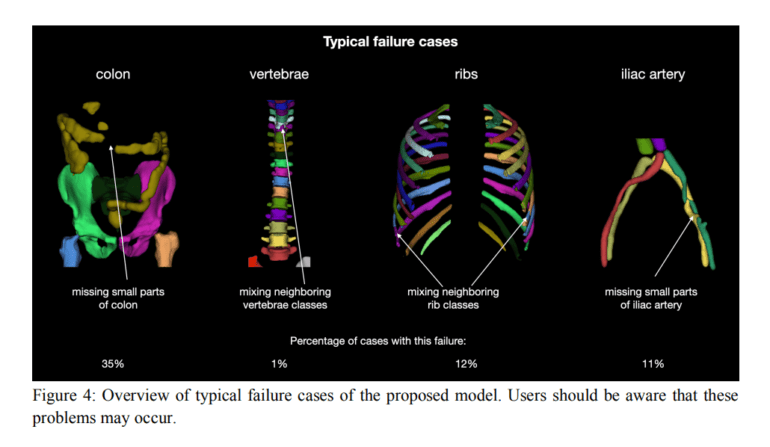TL;DR:
- University Hospital of Basel has introduced TotalSegmentator, a cutting-edge deep learning model for anatomical structure segmentation in CT images.
- TotalSegmentator can autonomously segment 104 anatomical entities with exceptional accuracy, boasting a Dice score of 0.943.
- The model is resource-efficient, requiring less than 12 GB of RAM and no dedicated GPU, making it accessible on standard computers.
- TotalSegmentator’s pre-trained Python package is freely available, along with an easily accessible dataset of over 4000 CT examinations.
- Applications of TotalSegmentator include advanced biomarker extraction, automated pathology detection, tumor load quantification, and more.
- The model sets a new standard for medical image segmentation, surpassing most other approaches, and is likely to shape the future of radiological research and clinical practice.
- Future studies aim to expand the dataset, include more anatomical structures, and conduct comprehensive correlation analyses to enhance our understanding of aging and medical imaging.
Main AI News:
In recent years, the volume of CT scans conducted has surged, accompanied by a remarkable expansion in data processing capabilities. The integration of deep learning methodologies has ushered in a new era in image analysis, significantly enhancing the capabilities of algorithms. These advancements, facilitated by improvements in data storage, processing speeds, and algorithmic quality, have enabled researchers to harness larger sample sizes for radiological investigations. At the heart of many of these research endeavors lies the critical task of anatomical structure segmentation.
Radiological image segmentation plays a pivotal role in the extraction of advanced biomarkers, the automated detection of pathologies, and the quantification of tumor loads. Furthermore, segmentation is an integral component of routine clinical analysis, serving essential functions in surgery and radiation planning. However, existing models for segmenting individual organs on CT images or combining data from multiple anatomical structures into a single model have significant limitations. They typically focus on only a subset of essential anatomical structures and are trained on datasets that do not accurately represent routine clinical imaging. The dearth of accessible segmentation models and datasets hampers the progress of researchers, often entailing laborious administrative procedures or reliance on unwieldy data providers with rate limitations.
Enter the innovative minds at the Clinic of Radiology and Nuclear Medicine, University Hospital Basel. They leveraged approximately 1204 CT datasets to develop a groundbreaking method capable of segmenting a remarkable 104 anatomical entities. This extensive dataset was acquired using CT scanners, encompassing diverse acquisition settings and contrast phases. Their creation, the TotalSegmentator, stands as a remarkable achievement in medical imaging, capable of autonomously segmenting most of the body’s crucial anatomical structures with minimal user intervention. What truly sets this tool apart is its exceptional accuracy, boasting a Dice score of 0.943, and its robust performance across a spectrum of clinical datasets. TotalSegmentator eclipses other freely available alternatives, making it a game-changer in the field of radiological segmentation.
Not content with just the development of this remarkable tool, the research team also utilized a vast dataset comprising over 4000 CT examinations to investigate age-related changes in volume and attenuation within various organs. The results of their study have far-reaching implications for the medical community.
To ensure widespread accessibility, the researchers have generously made their model available as a pre-trained Python package, opening doors for researchers and practitioners across the globe. Notably, TotalSegmentator’s resource-efficient design, which consumes less than 12 GB of RAM and negates the need for a dedicated GPU, means it can run seamlessly on standard computer systems. Furthermore, accessing their dataset is hassle-free, requiring no special permissions or convoluted requests for download. In employing a nnU-Net-based model, a proven stalwart in delivering reliable results across diverse tasks, TotalSegmentator sets a new standard for medical image segmentation, outpacing most other methodologies. Hyperparameter tuning and exploration of alternative models, such as transformers, have further amplified the model’s performance.
As elucidated in their research paper, the applications of this pioneering model are manifold. Beyond its immediate utility in surgical procedures, its rapid and accessible organ segmentation capabilities facilitate individualized dosimetry, exemplified in applications for the liver and kidneys. Automated segmentation opens avenues for enhancing research by equipping clinicians with normal or age-dependent parameters like Hounsfield units and volume. When coupled with a lesion-detection model, TotalSegmentator could be instrumental in approximating tumor loads for specific anatomical regions. Moreover, it lays the foundation for the development of disease identification models.
The impact of TotalSegmentator is palpable, with over 4,500 researchers downloading the model for diverse applications. The analysis of datasets of this magnitude was previously a monumental task, demanding extensive time and effort from data scientists. Their groundbreaking work has unveiled previously unseen associations between age and the volume of numerous segmented organs, utilizing a dataset of over 4000 individuals who underwent CT polytrauma scans. Notably, common references for normal organ sizes and age-related growth typically rely on sample sizes of a few hundred individuals.
The research team acknowledges the overrepresentation of male patients in their study datasets, which may be attributed to the higher average hospital visitation rate among men. However, they remain steadfast in their belief that TotalSegmentator marks only the beginning of more comprehensive radiological investigations. Future studies are poised to expand the dataset, encompassing a wider array of anatomical structures, while also accounting for potential confounding factors. Rigorous correlation analyses will further enrich our understanding of the aging process.
Conclusion:
TotalSegmentator from the Clinic of Radiology and Nuclear Medicine, University Hospital Basel, represents a monumental leap forward in the field of medical imaging. Its transformative capabilities and commitment to accessibility ensure that it will continue to shape the landscape of radiological research and clinical practice for years to come. This remarkable tool promises to revolutionize the way we perceive and utilize CT imaging, ultimately benefiting both patients and healthcare professionals alike.

